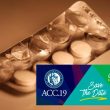Eighty years did the trick for one the countries with more experience in transcatheter aortic valve replacement (TAVR), which made it the new “standard of care” to treat elderly patients. Following in the footsteps of pioneer Alain Cribier, Germany has led the adoption of TAVR in Europe and the rest of the world. Since 2008,...
ACC 2019 | SMART-CHOICE: Aspirin Increasingly “Against the Ropes”
This work (presented during the same American College of Cardiology [ACC] 2019 Scientific Session as the STOPDAPT-2 trial) enrolled 2993 patients who underwent angioplasty with current-generation stents Xience, Promus, Synergy, or Orsiro at 33 Korean sites. Patients were randomized to 12 months of dual antiplatelet therapy or dropping aspirin at 3 months. There was no difference between the short-...
The Most Relevant Articles of 2018 in Peripheral Vascular Disease
1- What’s New in the European Guidelines on Peripheral Arterial Disease Since the last version of the European guidelines on the diagnosis and treatment of peripheral arterial disease in 2011, there have been many trials and registries that warrant guideline adjustments in many aspects. The first novelty is the teamwork that gave way to these...
The Most Relevant Articles of 2018 in Pharmacology and Clinical Cardiology – Part 2
1- What Antiplatelet Therapy Should We Use in Patients with Stroke/TIA? Interesting Results for the POINT Trial The New England Journal of Medicine (NEJM) recently published an article about the POINT trial (simultaneously presented at the European Stroke Organisation Conference), a long-awaited randomized clinical trial to assess the efficacy and safety of dual antiplatelet therapy...
The “Ten Commandments” of Myocardial Revascularization According to Europe
The new European guidelines on myocardial revascularization were developed by a joint effort of the European Society of Cardiology (ESC) and the European Association of Cardiovascular Surgery (EACTS). These guidelines are intended to support clinical practice with pragmatic recommendations based on currently available evidence and on personal experience, whenever evidence is missing. Both coronary angioplasty...
The Most Relevant Articles of 2018 in Pharmacology and Clinical Cardiology
1- New High Blood Pressure Guidelines The wait is finally over: the high blood pressure guidelines that have been in the works for the past 3 years saw the light of day at the American Heart Association (AHA) 2017 Scientific Sessions. Read more 2- New European Hypertension Guidelines Contrast with American Recommendations The European...
Left Main PCI Technique Could Change DAPT Duration
Up to 20% of patients undergoing left main PCI require a 2-stent technique, and this number should most likely grow after the DKCRUSH-V outcomes. However, this study contradicts the DKCRUSH-V and brings us back to “the simpler the better”, since patients undergoing 1 stent left main PCI presented less revascularization and less target vessel failure...
E-Cigarettes: No Definitive Evidence on Their Potential Cardiovascular Effect, but Some Suggest Caution
E-cigarettes may bring about cardiac risk according to a new literature review soon to be published in J Am Coll Cardiol. The evidence on potential harm is not definitive, but some experts suggest caution in their use until there is more solid evidence. E-cigarettes have been advertised as a healthy alternative to traditional cigarettes and...
Clinical Utility of CT-Derived FFR for Decision-Making
In this large international multicenter population, computed-tomography (CT)-derived fractional flow reserve (FFR) modified treatment recommendation in two-thirds of subjects compared with CT angiography alone, and it was associated with less negative invasive angiographies. It also predicted revascularization and identified low-risk patients. A non-invasive means to know the anatomy and function of patients with stable chronic...
Cautious Administration of Supplemental 02, Especially in Acute Stroke or MI
Recent studies show the potential damaging effect of supplemental oxygen in the context of acute stroke and myocardial infarction. Experts now say that it should not be used in patients with >92% oxygen saturation. These guidelines have looked into the most recent studies, including the DET02X-AMI, which suggest supplemental oxygen therapy could increase mortality in...









